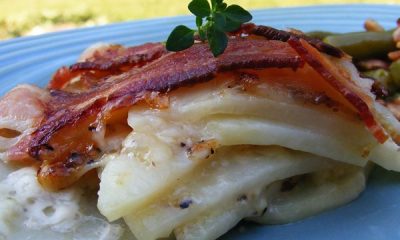Food Blogs
Pig Totter Stuffed Potato Recipe

| Servings |
MetricUS Imperial
|
Ingredients
- 4 long pig’s trotters
- Sea Salt
- stock vegetables and herbs what you have to hand
- 1 head of garlic separated into cloves
- ½ bottle of red wine
- 3 pounds good mashing potatoes e.g. Maris Piper
- 2 Shallots peeled and sliced
- duck fat or extra-virgin olive oil
- black pepper
- caul fat your butcher should have no problem obtaining this for you
Ingredients
|

|
Instructions
- Singe all the hair off the trotters, then bone them out. Chefs have likened this to being as easy as removing a kid glove, but if you don’t find this, don’t get disheartened. Start at the other end from the hoof, cut under the skin as close to the bone as possible (avoid cutting through the skin), work your knife further down the trotter following the bone round, you should get down to the first claws! Now roll the skin down the trotter towards the nails, you come to the two nails sticking out to the side, cut these at the join so they stay part of your trotter skin, ease the skin down a wee bit further to the main joint, before the cloven hooves!! Give this a firm bend until it cracks, and finish splitting with a knife. Sprinkle the trotter skins with salt and put them in the fridge.
- Pop the bones into a pot with your stock vegetables and herbs, and cover with water. Bring them to the boil and simmer for 2½ hours, skimming regularly. When done, strain the liquor, and discard the bones and vegetables.
- Shake the salt off the trotters and lay them in a baking pan. Nestle in the cloves of garlic, and cover with a mixture of the pig’s trotter stock and red wine. Cover with tinfoil and place in a medium oven. Cook for approximately 3 hours then check; it’s cooked when your fingers easily meet if you pinch the trotter skin. You have to be careful at this point: you want your trotters well cooked but not collapsing! Leave to cool in the liquor, but remove before it has turned to jelly.
- At this point you can put them in the fridge if you have had enough for one day, but remember to bring them out in plenty of time before the final stage to warm up, as when cold they will not be so malleable.
- Meanwhile peel and cook your potatoes in salted water, until soft and ready for mashing. Drain then mash them (or put through your mouli) without adding anything. Fry your shallots in a healthy spoonful of duck fat or olive oil, until soft but not brown. Mix these and the fat into your pure mash, and season. Let this mixture cool to a handleable temperature. Fill your trotter skins with the mixture—not too full, as the potato will expand, but so as they look like whole trotters again. Then wrap each trotter in a layer of caul fat, keeping this as thin as possible. At this point it is good to let the reconstructed trotters rest overnight in the fridge.
- To cook the trotters, heat an ovenproof frying pan, add a spoonful of duck fat or olive oil, season the wrapped trotters and brown them, being careful not to puncture the caul layer, then place them in a hot oven for 15–20 minutes. The caul should all but cook away, leaving a crispy trotter full of giving swollen mash, which has supped up the sticky goodness of the trotter. Eat hot with watercress.




















